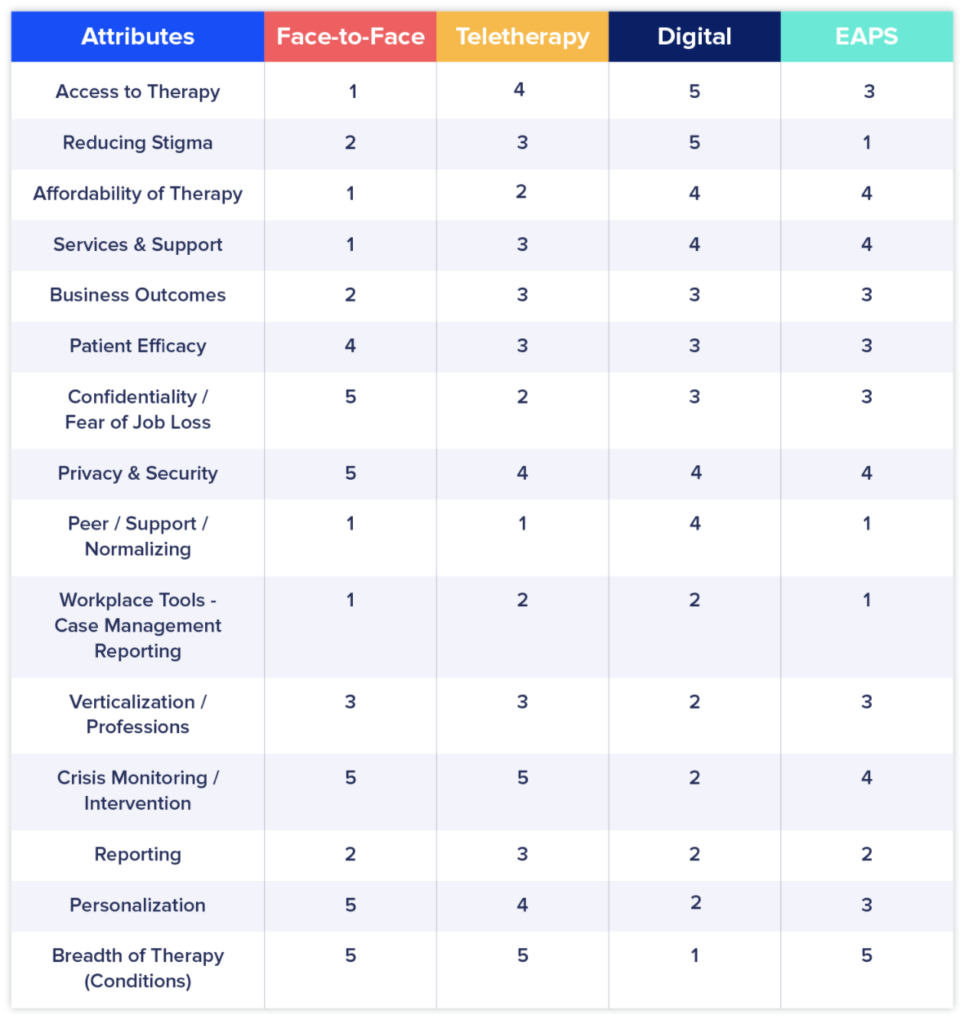Burnout is real, especially since the onset of the pandemic as millions of employees continue to blur the lines between work and home life throughout the day. Employee mental health is declining, but 43% of employees do not feel that their employer is adequately addressing burnout, despite its prevalence in the workplace.
According to the latest research by Indeed:
- Over half (52%) of employees are experiencing burnout in 2021—up from 43% before the pandemic
- 53% of Millennials were burning out before the pandemic, and they remain the most affected population, with 59% experiencing it today
- Gen-Z is now neck and neck with Millennials, as 58% report burnout—up from 47% in 2020
- More than half (54%) of Gen-Xers are burned out—a 14% jump from the 40% in 2020
- Baby Boomers also show a 7% increase in burnout from 24% to 31%
HR leaders continue to invest in countermeasures to lower the impacts of stress, anxiety, and burnout, most recently levelling up their EAP offerings and increasing employee mental health benefits. Unfortunately, despite these measures, claims related to mental health continue to rise at unprecedented rates.
Recently, HR leaders from across the country participated in a roundtable discussion hosted by Starling Minds to share their knowledge and insights into the challenges HR leaders face in today’s workplace.
According to our roundtable panellists, the key challenges HR leaders are struggling with are:
- Rising STD and LTD claims for the young and ageing employee population
- Lack of transparency into claims
- Building Psychological Health and Safety in the workplace
- Complexities in mental health claims
- Access to the right treatment at the right time
- Building a good employee experience for workers on disability
Rising Short-Term and Long-term Disability Claims
According to the Indeed report, both the ageing and young employee populations are shifting from sick leave to short-term and long-term disability. For the ageing employee population, more than 46% of people over the age of 60 will face one or more disabilities due to an accumulation of health risks across a lifespan of disease, work-related musculoskeletal injuries, and chronic illness.
For Gen Z and Millennials, this rising trend is difficult to attribute to one cause, as it’s often a tangle of interrelated causes and effects. This includes uncertainty in career prospects, business and economic downturn, long-term financial pressures, negative aspects of social media, and falling short of life expectations, compounding to frightening levels of stress, anxiety, loneliness, burnout, and depression.
Despite the efforts of HR leaders and society in reducing stigma around mental health, 40% of employees who cite feeling stressed all the time will choose to work through it, leading to delays in HR intervening and recommending resources until the employee’s functioning is noticeably impacted.
It’s hard to get to employees who are struggling silently. HR as a practice can only intervene if we see something is wrong, but often we can’t see a mental health condition like how we can see a physical illness or injury. – HR Panelist, Director of People and Culture
Lack of transparency into claims
As a result of privacy and confidentiality legislation, employers will never have access to employee data beyond aggregated reporting – for good reason as it protects employees’ personal health information. However, the lack of visibility and line of sight into mental health claims and employee progression often limit HR and People leaders and their ability to support employees and focus resources in the right areas. Without deeper insights into their employees, HR teams cannot deliver the right level of support, accommodations, and resources needed to get the individual back to work and sustain it.
“Often, we will not know if an individual is off for mental health reasons unless the employee tells us. Our insurer is reluctant to provide this information, and although it’s understandable, it can also be extremely frustrating.” – HR Panelist, Head of Compensation and Benefits
Lack of Psychological Health and Safety in the workplace
Leaders and managers can play a crucial role in enabling a culture that is both psychologically healthy and safe for employees. A psychologically healthy and safe workplace promotes employee psychological well-being. It actively works to prevent harm to their mental health and normalizes conversations around it through employee-centric policies, mental health awareness and education, and leader and manager training.
But building psychological health and safety within a workplace is timely, costly, and seen as disruptive to managers despite the Mental Health Commission of Canada (MHCC) developing a comprehensive implementation guide. It takes multiple stakeholders, leadership and manager buy-in, and subject matter experts with an intimate understanding of the standards and application to different workplaces and contexts to truly build it within a workplace.
When our HR team had sent out communications to raise awareness around mental health, I received an email from a manager asking us to change the word mental health to something more positive. It just goes to show how difficult it is to get managers, the culture carriers within our organization to speak about mental health at a level that is needed to normalize it. – HR Panelist, Health and Wellness Consultant
Complexities in mental health claims
In recent years, the academic and scientific community has taken a more holistic approach to health, focusing on the connection between physical, mental, emotional, and social wellbeing to someone’s overall health. An impact on one area can have immediate effects on others. For example, when someone gets physically injured at work, they have a 50% chance of developing a mental health diagnosis (a co-morbidity). As a result, mental health claims become more complex and layered with multiple diagnoses on files. Our healthcare system for mental health support is also complex and difficult to navigate through due to the decentralization of mental health services. Employers, leaders, and managers want to help but often lack the knowledge and insights needed to help employees navigate the complexities of their mental health struggles.
I’m consistently hearing about the complexity of mental health conditions from our HR partners or from managers and what resources can be shared with employees. Unfortunately, complex claims often impact the continuity of the treatment and care we offer to employees. – HR Panelist, Wellness and Accessibility Leader
Access to the right treatment at the right time
For HR and People leaders, failing to intervene early can lead to many negative consequences on their employee’s mental and physical health and overall business. As a result, their problems often become more serious, more damaging and more difficult to address.
As a society, we know the importance of detecting signs of a physical illness and getting treatment to address it. Unfortunately, the same principle is not being applied to mental health. Instead, our healthcare systems and workplaces often detect and deliver mental health resources much later, leading to more costly interventions for the individual and the organization.
Our biggest challenge right now is having access to the right treatment at the right time. Unfortunately, a lot of folks don’t have family physicians who are often the gatekeeper to getting help. – HR Panelist, Disability Management Specialist
Building a good employee experience
While organizations are championing equity and inclusion, there are still areas that need improvement, especially with employees on leave or disability.
Employees who have been on disability leave are one of the largest minority groups within an organization. However, their experience off work is overlooked by their managers. According to a Global Disability Inclusion Report with Mercer, 90% of corporations report being committed to inclusion efforts, but only 4% have a disability inclusion focus, and less than 5% would evaluate the employee experience of those with disabilities or on disability. Without a team’s commitment to staying in contact with their teammate on leave, they are less likely to return to work sooner and sustain it. Moreover, many are likely to leave their job after their claim.
We need to understand what the employee experience is and how they are feeling when they’re back at work. A successful return to work is not successful if they aren’t happy or accommodations aren’t in place for them. – HR Panelist, Absence and Disability Manager
Despite these challenges, there is hope. Our roundtable panellists included some best practices and actionable insights leaders can take and implement within their employee wellness, absence and disability programs.
Early Intervention Resources
Early intervention is key to mitigating absence and disability claims associated with mental health.
For HR and People leaders, it’s important to view your mental health programs as an ecosystem within an overall health strategy by providing a wide range of mental health supports that complement one another and drive more value together than any one component can deliver on its own.
For our HR panellists, this means considering how EAPs/EFAPs, digital mental health solutions, mental health training, and online peer communities can be made available to employees as a combined offering.
For most organizations, this approach will enhance their existing mental health program and tackle some of the key challenges facing HR and People leaders today.
Employee Assistance Programs
EAPs/EFAPs can help address challenges around mental health claim complexities. The programs are often a large part of a workplace’s mental health ecosystem and provide employees access to various therapies, including face-to-face and teletherapy to best handle complex claims.
As a result of the pandemic, EAPs/EFAPs utilization rates have increased as employees seek support to better manage their mental health during social distancing and economic and health uncertainties. But, EAP/EFAP programs often rely on human-guided support to help struggling employees, which introduces wait times and costs in the therapy experience, and an employee’s continuity of care as most benefits run out after 3 or 4 sessions. HR and People Leaders should work with their EAP/EFAP providers to extend their benefit offerings for human-guided support, alongside digital mental health options to remove wait times and costly interventions for less complex claims.
Digital Mental Health Options
As a result of the pandemic, more HR and People leaders have sought digital mental health options to scale access to immediate, affordable mental health support. Digital options make mental healthcare available to anyone with a mobile phone, tablet or computer. It helps alleviate many continuity of care concerns by supplementing in-person therapy sessions, especially when therapists aren’t available due to benefits running out. A digital mental health platform with a CBT component is becoming the gold standard due to its ability to offer immediate, unlimited sessions and a pragmatic way of building up an employee’s mental health or mental fitness training on a daily basis.
Digital mental health options may also have good case manager reporting to help organizations gain better transparency and line of sight into employee mental health progression and skills learned throughout their journey.
Leadership and Management Training
Rising disability claims, lack of psychological health and safety within a workplace, and failure to consider the employee experience can be attributed to small or large mental health literacy gaps among leaders and managers. Employees are going on disability due to heightened stress, anxiety, and burnout alongside their tendency to work through their struggles without help.
It is critical that leaders and managers advocate for better workplace mental health strategies and psychological health and safety within their workplace through psychoeducation – the building of mental health knowledge. But providing psychoeducation across an organization is timely and costly due to scalability issues. Therefore, digital mental health solutions with psychoeducation built into their programs will be critical in training leaders and managers about mental health and how to support employees who may be soldiering through their mental health struggles.
Leader and manager training can also build awareness around employees’ experience on leave, STD, LTD, or returning to work. Training leaders, managers, and colleagues on how to support employees can lead to a more inclusive, engaging experience for those on leave and stronger return-to-work and stay-at-work outcomes for the organization.
Online Peer Communities
Today, more organizations recognize the power of community and are setting up internal communication channels as a safe place where employees can share their mental health experiences. Some digital mental health solutions are already using online peer support communities alongside their digital mental health solution to go beyond individual treatment by tapping into the human need for social and emotional connections. Online peer communities create a sense of hope and validation in employees by receiving support, acknowledgement, and encouragement from peers, anonymously. It also helps them feel less alone in their struggles with mental health. With an online or digital peer community, HR and People leaders can gain further line of sight into what is going on within their organization and how employees are feeling.
How to measure the success of absence and disability programs
Data is a critical component in improving an organization’s employee wellness and absence and disability management programs. It allows leaders to focus on key areas and solutions driving value for their employees. The following metrics are important in evaluating workplace programs and ensuring they are driving the right outcomes for organizations:
- User engagement rates
- User efficacy rates
- Change in costs associated with disability claims
- Change in the number of disability claims
- Change in duration of disability claims
- Employee engagement and satisfaction rates
- Return-on-investment
Summary
In summary, there are six significant challenges HR and People leaders are facing in today’s workplace:
- Rising STD and LTD claims for the young and ageing employee population
- Lack of transparency into claims
- Building Psychological Health and Safety in the workplace
- Complexities in mental health claims
- Access to the right treatment at the right time
- Building a good employee experience for workers
To help address some of these challenges, our HR panellists believe that employee assistance programs, digital mental health solutions, leadership and manager training, and online peer communities are all needed to create a total workplace mental health strategy fit for today’s complex workplace landscape.
The chart below illustrates how face-to-face, teletherapy, digital mental health and EAPs can all work in harmony to deliver a more robust framework for employee mental health.
For each modality of treatment, a score is aligned, with five being the highest.

Discover how digital mental health can fit into your organization and address some key employee mental health challenges.




